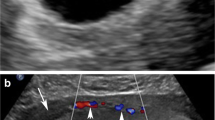Abstract
A 34-year-old female was admitted at 34 weeks of gestation with sudden onset of a severe headache accompanied by vomiting. Neurological examination revealed neck rigidity, and computed tomography (CT) of the brain revealed a subarachnoid hemorrhage (SAH). Although the hemorrhage was located primarily in the left Sylvian fissure, computed tomography angiography (CTA) performed immediately after CT did not reveal any obvious vascular abnormalities such as an intracranial aneurysm. An emergency cesarean section was performed, and a healthy infant was delivered. Cerebral digital subtraction angiography (DSA) was performed the day following surgery, which revealed a saccular aneurysm measuring 4.3 mm × 2.4 mm in the left middle cerebral artery. Left craniotomy and clipping of the aneurysm were performed. The clot around the aneurysm was relatively solid. This case report is of significance given that initial CTA was negative for SAH during pregnancy, suggesting the requirement for immediate DSA or another CTA in such cases. There are many previous reports on false-negative CTA findings or disappearance and reappearance of aneurysms in SAH patients, and various biophysical and dynamic parameters are suggested to cause such phenomena. However, there are no reports on similar occurrences during pregnancy. Although the precise cause remains unclear, multiple factors associated with homeostasis during pregnancy were possibly associated with the transient disappearance in this patient.


Similar content being viewed by others
References
McKinney AM, Palmer CS, Truwit CL, Karagulle A, Teksam M (2008) Detection of aneurysms by 64-section multidetector CT angiography in patients acutely suspected of having an intracranial aneurysm and comparison with digital subtraction and 3D rotational angiography. AJNR American journal of neuroradiology 29(3):594–602. doi:10.3174/ajnr.A0848
Westerlaan HE, van Dijk JM, Jansen-van der Weide MC, de Groot JC, Groen RJ, Mooij JJ, Oudkerk M (2011) Intracranial aneurysms in patients with subarachnoid hemorrhage: CT angiography as a primary examination tool for diagnosis—systematic review and meta-analysis. Radiology 258(1):134–145. doi:10.1148/radiol.10092373
Agid R, Andersson T, Almqvist H, Willinsky RA, Lee SK, terBrugge KG, Farb RI, Soderman M (2010) Negative CT angiography findings in patients with spontaneous subarachnoid hemorrhage: when is digital subtraction angiography still needed? AJNR American journal of neuroradiology 31(4):696–705. doi:10.3174/ajnr.A1884
Tiel Groenestege AT, Rinkel GJ, van der Bom JG, Algra A, Klijn CJ (2009) The risk of aneurysmal subarachnoid hemorrhage during pregnancy, delivery, and the puerperium in the Utrecht population: case-crossover study and standardized incidence ratio estimation. Stroke; a journal of cerebral circulation 40(4):1148–1151. doi:10.1161/strokeaha.108.539700
Willinsky RA, Taylor SM, TerBrugge K, Farb RI, Tomlinson G, Montanera W (2003) Neurologic complications of cerebral angiography: prospective analysis of 2,899 procedures and review of the literature. Radiology 227(2):522–528. doi:10.1148/radiol.2272012071
Lubicz B, Levivier M, Francois O, Thoma P, Sadeghi N, Collignon L, Baleriaux D (2007) Sixty-four-row multisection CT angiography for detection and evaluation of ruptured intracranial aneurysms: interobserver and intertechnique reproducibility. AJNR American journal of neuroradiology 28(10):1949–1955. doi:10.3174/ajnr.A0699
Nakajima Y, Yoshimine T, Mori H, Nakamuta K, Fujimura I, Sakashita K, Kohmura E, Hayakawa T, Yokota J (2000) Spontaneous disappearance and reappearance of a ruptured cerebral aneurysm: one case found in a group of 33 consecutive patients with subarachnoid hemorrhage who underwent repeat angiography. Neurological research 22(6):583–587
Fodstad H, Liliequist B (1979) Spontaneous thrombosis of ruptured intracranial aneurysms during treatment with tranexamic acid (AMCA). Report of three cases. Acta neurochirurgica 49(3–4):129–144
Thornton P, Douglas J (2010) Coagulation in pregnancy. Best practice & research Clinical obstetrics & gynaecology 24(3):339–352. doi:10.1016/j.bpobgyn.2009.11.010
Var A, Yildirim Y, Onur E, Kuscu NK, Uyanik BS, Goktalay K, Guvenc Y (2003) Endothelial dysfunction in preeclampsia. Increased homocysteine and decreased nitric oxide levels. Gynecologic and obstetric investigation 56(4):221–224. doi:10.1159/000074824
Conflict of interest
The authors declare that they have no conflict of interest.
Author information
Authors and Affiliations
Corresponding author
Rights and permissions
About this article
Cite this article
Goto, Y., Ebisu, T. & Mineura, K. Ruptured intracranial aneurysm during pregnancy with false-negative computed tomography angiography findings: a case report. Emerg Radiol 22, 343–346 (2015). https://doi.org/10.1007/s10140-015-1306-9
Received:
Accepted:
Published:
Issue Date:
DOI: https://doi.org/10.1007/s10140-015-1306-9




